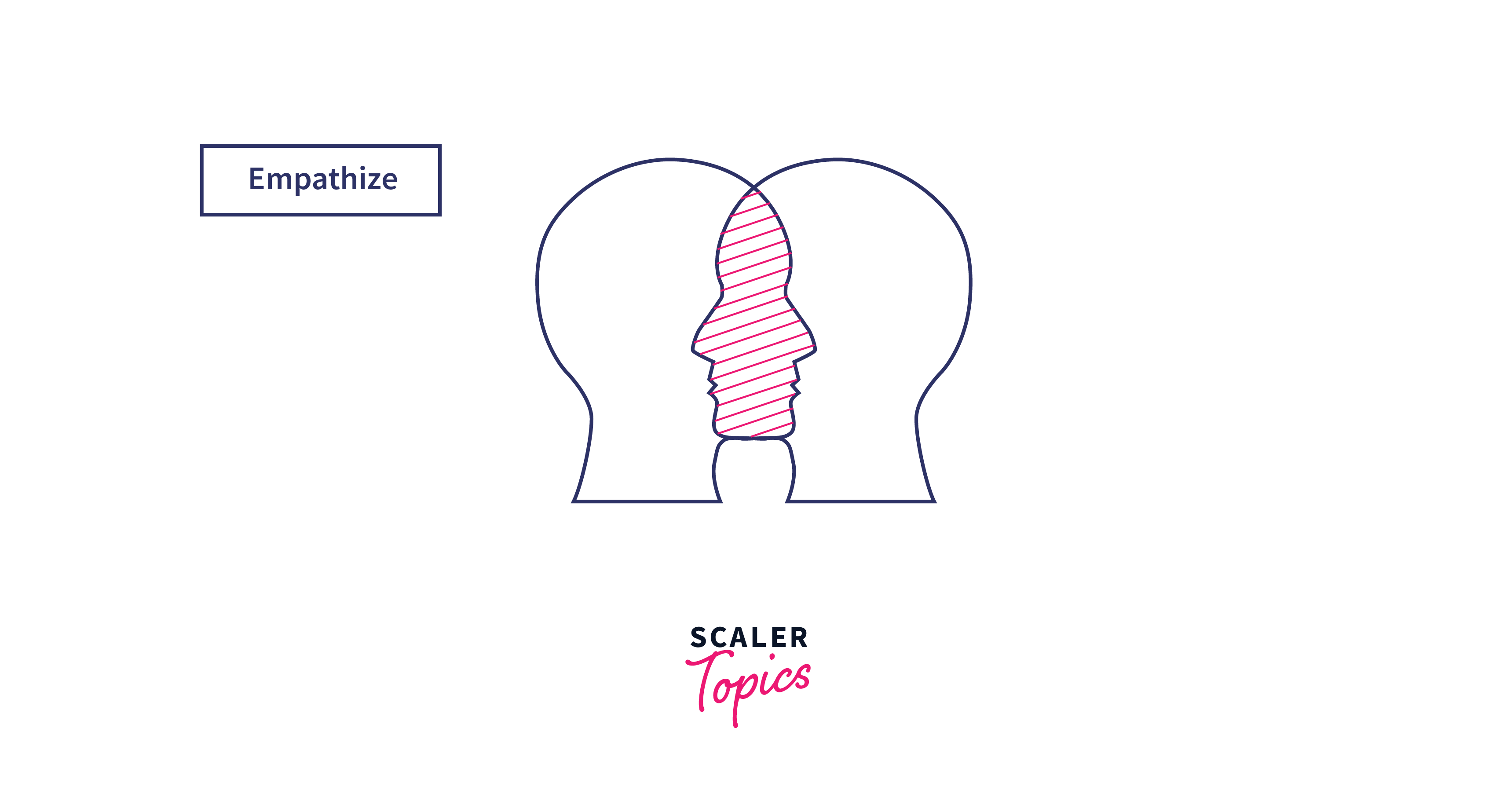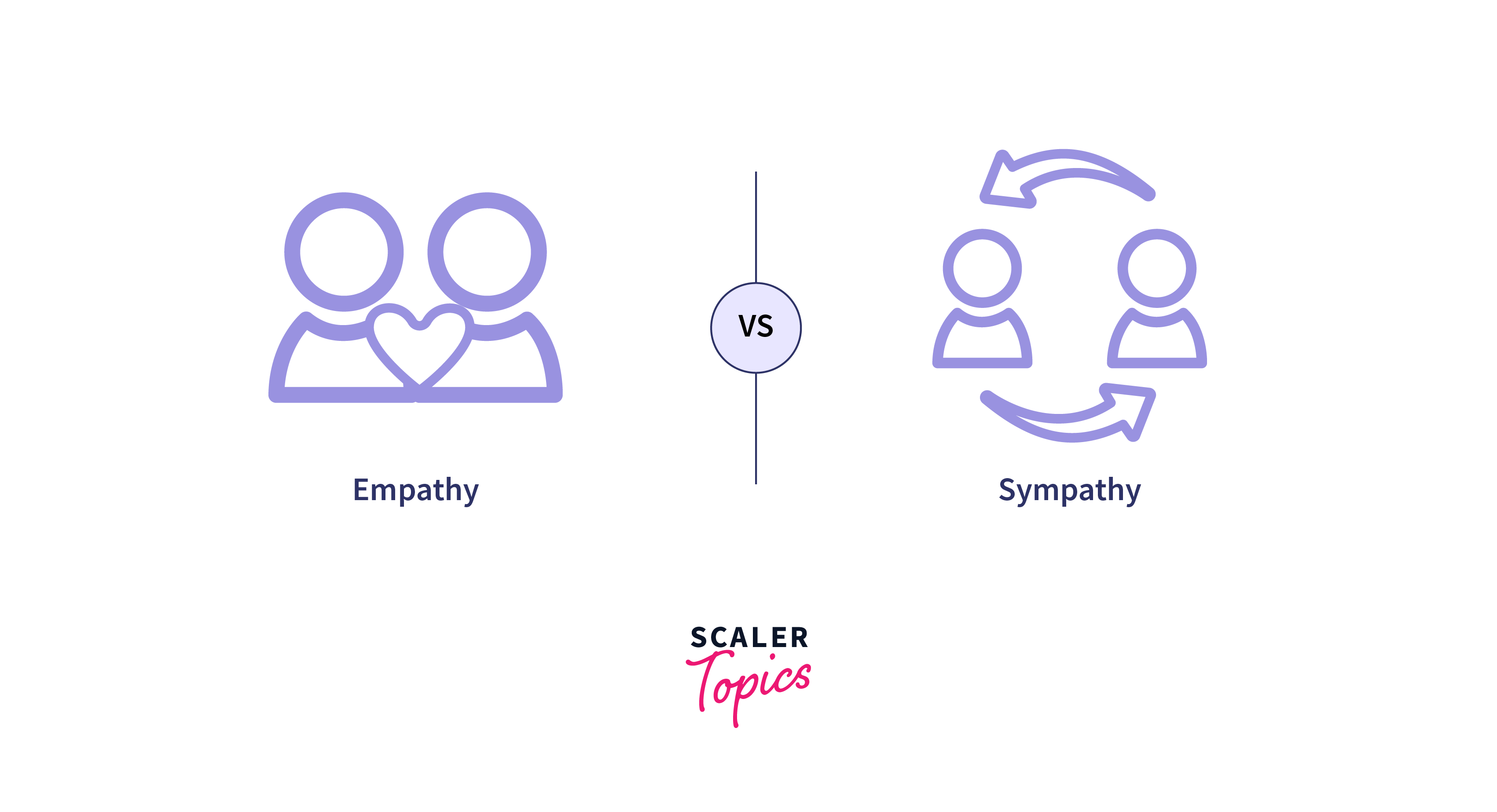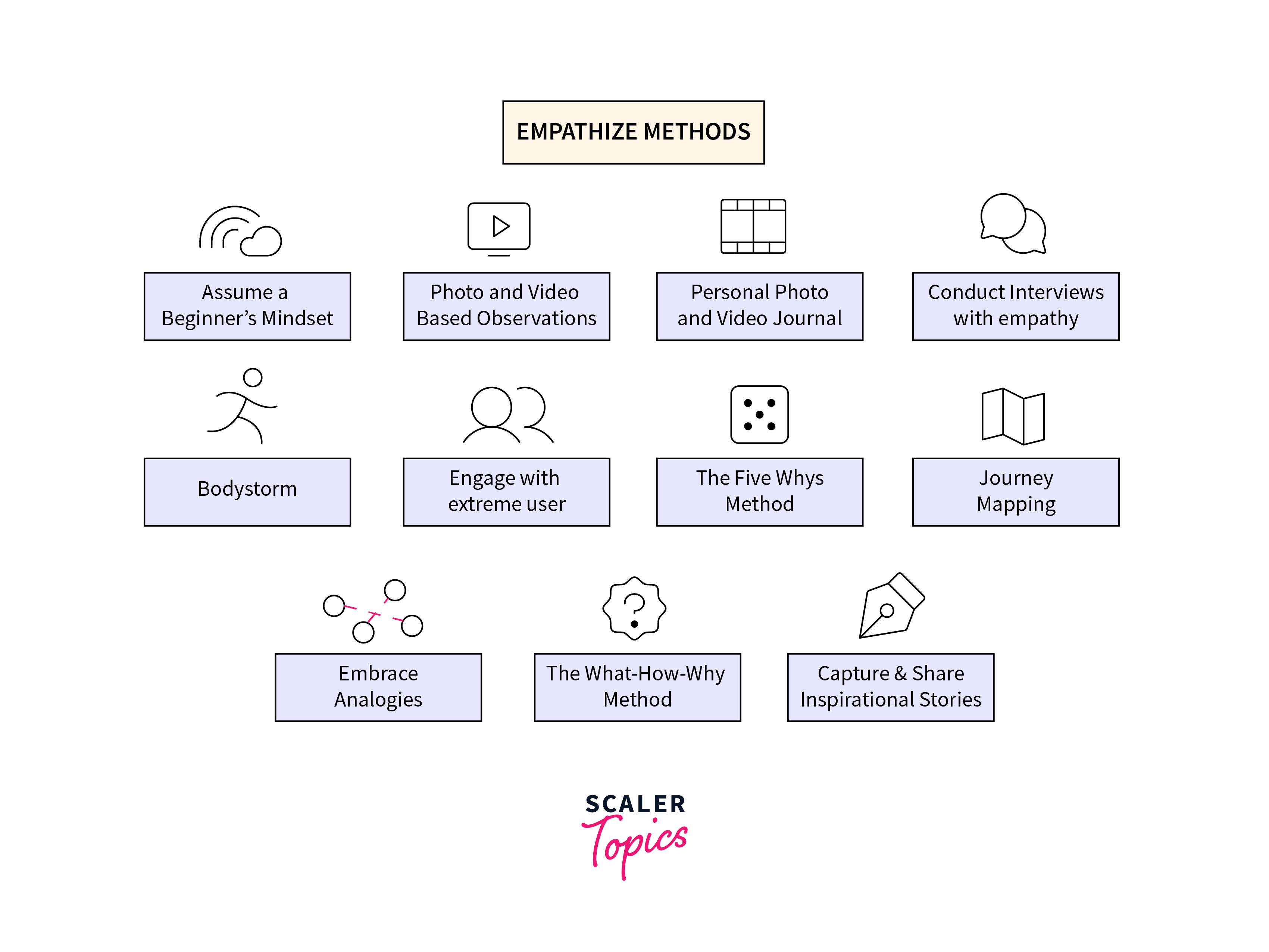What is Empathy in Design Thinking?
Empathy in design thinking refers to the skill of comprehending and empathizing with the emotions, requirements, and viewpoints of users. It includes actively listening, observing, and immersing oneself in the user's journey to develop products and solutions that genuinely cater to their needs and difficulties.
What is Empathic Design?
Empathic design, also known as empathy-driven design, is an approach to design that emphasizes understanding and considering the perspectives, experiences, and emotions of the end-users throughout the design process. The goal is to create products, services, or solutions that genuinely meet the needs and preferences of the users by developing a deep understanding of their feelings, behaviours, and challenges.

Key principles and elements of empathic design include:
-
User Empathy: Designers strive to empathize with the users, putting themselves in the user's shoes to understand their thoughts, feelings, and motivations.
-
User Research: Extensive research is conducted to gather insights into the users' lives, preferences, and behaviours. This may involve interviews, observations, surveys, and other methods to gain a holistic understanding.
-
Persona Development: Creating personas, fictional representations of different user types, helps designers better grasp their target audience's diverse needs and goals.
-
User Journey Mapping: Mapping out the user's journey and interactions with a product or service helps identify pain points, opportunities for improvement, and moments that matter to the user.
-
Iterative Prototyping: Designers often create prototypes early in the process and iterate based on user feedback. This iterative approach allows for continuous refinement based on user input.
Real-Life Example of Empathy in Design Thinking:
Airbnb's Experiences:
Airbnb is known for incorporating empathy into its design process. In expanding their platform beyond accommodations, Airbnb introduced "Experiences." Before launching, the design team conducted extensive research, including interviews and immersive experiences with both hosts and guests. By empathizing with the desires and concerns of users, Airbnb was able to create a platform that goes beyond transactional relationships, fostering connections and unique experiences. The empathic design approach helped shape the user experience to align with the emotional and social needs of both hosts and guests.
How does Empathy Help?
Here are several ways in which empathy in the design thinking process contributes to and enhances the quality of the final product:
-
Understanding User Needs: Empathy allows designers to gain a deep understanding of users' needs, desires, and challenges. By putting themselves in the users' shoes, designers can identify pain points and opportunities for improvement.
-
User-Centered Design: Empathetic design places the user at the centre of the design process. This user-centric approach ensures that the final product is tailored to meet the specific requirements and preferences of the target audience.
-
Identification of Pain Points: Empathy helps designers identify and address the pain points or frustrations that users may experience. This, in turn, allows for the creation of solutions that directly alleviate these challenges.
-
Enhanced User Experience: Designing with empathy leads to a more intuitive and enjoyable user experience. By understanding the emotions and motivations of users, designers can create interfaces and interactions that resonate positively.
-
Effective Communication: Empathetic designers can communicate more effectively with users and stakeholders. They can understand and address concerns, articulate design decisions, and create marketing messages that resonate with the target audience.
-
Iterative Improvement: By continuously seeking feedback and iterating on designs based on user input, empathetic designers can refine and improve their solutions over time.
-
Social Impact: Empathy in design thinking can extend beyond individual products or services to address broader social issues. Designers who empathize with the larger community may create solutions that have a positive impact on society.
Difference between Empathy and Sympathy

| Aspect | Empathy | Sympathy |
|---|---|---|
| Definition | Understanding and sharing the feelings of another person. | Feeling compassion or pity for someone else's situation. |
| Emotional Connection | Involves a deep emotional connection, sharing the emotional experience. | Involves acknowledging and expressing concern without necessarily sharing the emotional experience. |
| Shared Experience | Often results in a shared emotional experience. | Does not necessarily involve sharing the emotional experience. |
| Response | May lead to an active desire to support or help based on a deep understanding. | Often involves a more passive expression of care or concern. |
| Focus | Focuses on understanding and validating the other person's emotions. | Focuses on acknowledging and expressing sympathy without necessarily understanding the emotions deeply. |
| Example Phrase | "I understand how you feel; I've been through something similar." | "I'm sorry to hear that you're going through a tough time. If there's anything I can do to help, please let me know." |
| Connection | Builds a strong emotional bond and connection. | May not create the same level of emotional connection. |
| Inclusive Perspective | Puts oneself in the other person's shoes, fostering a holistic understanding. | Expresses care for the person's situation without necessarily fully understanding their perspective. |
| Impact on Relationships | Strengthens relationships by fostering a sense of shared understanding. | May express support but might not contribute as significantly to a deep emotional connection. |
Where does Empathy Fit into the Design Thinking Process?
The Design Thinking process typically consists of the following stages:
-
Empathize:
- In this phase, designers immerse themselves in the users' world, using methods like interviews and observations. The goal is to understand users' needs, emotions, and challenges deeply, fostering an empathetic mindset to inform the design process.
-
Define:
- Following Empathize, Define involves synthesizing gathered insights to articulate a precise problem statement. Activities include persona creation and problem framing, ensuring a focused and human-centred definition that guides subsequent ideation and prototyping efforts in the Design Thinking process.
-
Ideate:
- Once the problem is well-defined, the ideation phase begins. Designers brainstorm and generate a wide range of creative ideas to address the identified challenges. Empathy continues to play a role here, as designers consider solutions from the perspective of the users and their unique needs.
-
Prototype:
- Designers create tangible representations or prototypes of their ideas. Prototypes can be physical models, digital simulations, or other representations that allow designers to test and gather feedback on their concepts.
-
Test:
- The final stage involves testing the prototypes with users to gather feedback and refine the solutions further. Through testing, designers can identify what works well and what needs improvement, ensuring that the final design is truly user-centred and effective.
Teaching Empathy in the Design Thinking Process
Here are ways to teach empathy in the Design Thinking process:
-
Case Studies and Examples:
- Share case studies and examples of successful design projects that resulted from a strong emphasis on empathy. Highlight how understanding users' perspectives led to innovative and user-centered solutions.
-
Real-world Immersion:
- Encourage students or participants to immerse themselves in real-world scenarios. This could involve site visits, field research, or engaging with communities to gain firsthand insights into users' lives.
-
Empathy Interviews:
- Conduct empathy interviews as a practical exercise. Guide participants in conducting interviews with real users, focusing on understanding their emotions, experiences, and challenges.
-
Empathy Building Activities:
- Incorporate empathy-building activities and exercises into the curriculum. These can include role-playing, storytelling, or interactive workshops that simulate real-life scenarios and help participants practice putting themselves in others' shoes.
-
User Persona Creation:
- Guide participants in creating user personas based on their research. This involves crafting detailed profiles of fictional users, considering their needs, goals, and pain points.
Empathize Methods
Here are various methods for empathizing with users in the design process:

-
User Interviews:
- Conduct one-on-one interviews to gather insights into users' thoughts, feelings, and experiences.
-
Observation:
- Observe users in their natural environment to understand behaviours, challenges, and interactions.
-
Ethnographic Studies:
- Immerse yourself in users' lives through extended observations, aiming to uncover hidden needs and cultural influences.
-
Surveys and Questionnaires:
- Collect quantitative data and identify trends by distributing surveys to a larger group of users.
-
Empathy Mapping:
- Visually represent users' thoughts, feelings, and actions to gain a deeper understanding of their experiences.
-
Persona Development:
- Create fictional characters based on user research to represent different user segments.
-
Role-playing:
- Engage in role-playing activities to simulate user experiences and understand their perspectives.
-
Shadowing:
- Follow users throughout their daily activities, observing and documenting their experiences.
-
User Diaries or Journals:
- Ask users to maintain diaries or journals to record their experiences over time.
Empathy is Crucial to Business Success
Here are some key ways in which empathy contributes to business success:
-
Understanding Customer Needs:
- Empathy allows businesses to understand the needs, desires, and pain points of their customers. By putting themselves in the customers' shoes, businesses can tailor their products and services to better meet customer expectations.
-
Customer Satisfaction and Loyalty:
- When customers feel understood and valued, they are more likely to be satisfied with the products or services they receive. Satisfied customers are more likely to become repeat customers and advocates for the brand, contributing to long-term loyalty.
-
Innovation and Problem-Solving:
- Empathy is a catalyst for innovation. Understanding the challenges and experiences of customers enables businesses to identify opportunities for improvement and innovation.
-
Effective Communication:
- Empathy enhances communication both within the organization and with customers. Businesses that empathize with their employees can foster a positive and collaborative work environment.
-
Employee Engagement and Productivity:
- Empathetic leadership and management contribute to a positive workplace culture. When employees feel understood and supported, they are more engaged, motivated, and productive.
-
Adaptability and Market Relevance:
- Empathetic businesses are more attuned to changes in customer preferences, market trends, and societal shifts. This awareness allows them to adapt quickly, stay relevant, and respond effectively to evolving consumer demands.
-
Brand Reputation:
- Businesses that demonstrate empathy in their actions and decision-making build a positive brand reputation. Consumers are increasingly drawn to socially responsible and empathetic brands, and a positive reputation can contribute to a competitive advantage.
-
Example:
- Apple's User-Centric Design:
Apple is renowned for its user-centric design philosophy, which is deeply rooted in empathy. Steve Jobs and his team understood the importance of not just meeting but exceeding customer expectations. The design of products like the iPhone and iPad reflects a deep understanding of user needs, preferences, and the desire for seamless, intuitive experiences.
Empathy Helps You Read Between the Lines
Here's how empathy contributes to understanding the underlying emotions, intentions, and unspoken messages in communication:
-
Sensitivity to Non-Verbal Cues:
- Empathy allows individuals to pick up on non-verbal cues such as facial expressions, body language, and tone of voice. These cues often convey emotions and nuances that may not be explicitly stated in words.
-
Understanding Emotions:
- Empathy encompasses the capacity to comprehend and resonate with the emotions of those around us. When reading between the lines, empathetic individuals can discern the emotional undertones of a message.
-
Recognizing Unspoken Needs:
- Empathy helps individuals anticipate and recognize the unspoken needs of others. By empathizing with someone's situation, one can infer what the person may require or desire without it being explicitly stated.
-
Contextual Understanding:
- Empathetic individuals consider the broader context of a conversation or situation. Understanding the context helps in interpreting the intended meaning behind the words. Empathy allows individuals to appreciate the background, circumstances, and emotions that shape communication.
-
Acknowledging Subtext:
- Empathy enables individuals to acknowledge and interpret the subtext—the implied or underlying messages—in communication. This involves understanding the hidden meanings, intentions, or motivations that may not be overtly expressed.
-
Effective Listening:
- Empathetic listening involves not just hearing the words but understanding the emotions and perspectives behind them. When reading between the lines, empathetic individuals actively listen and respond to the emotional content of the message, fostering deeper connections.
-
Cultural Sensitivity:
- Empathy helps individuals navigate cultural nuances and differences. In cross-cultural communication, where not everything may be explicitly stated, empathy allows for a deeper understanding of cultural norms, expectations, and unspoken rules.
Become Conscious of Your Empathy
Below are some steps to help you become more aware of and intentional about your empathy:
-
Self-Reflection:
- Take time for regular self-reflection. Consider your interactions with others and think about how you've responded to their emotions. Ask yourself questions like: "How did I feel in that situation?" and "How did I respond to the emotions of others?"
-
Mindfulness Practices:
- Engage in mindfulness practices to stay present in the moment. Mindfulness helps you become more attuned to your own emotions and those of others. Techniques such as meditation, deep breathing, or mindful listening can enhance your overall awareness.
-
Journaling:
- Keep a journal to record your thoughts and feelings in various social situations. Documenting your experiences can help you identify patterns, strengths, and areas for improvement in your empathetic responses.
-
Seek Feedback:
- Ask for feedback from friends, family, or colleagues regarding your empathy. Request specific examples of when they felt you were empathetic or times when they think you could have been more understanding.
-
Practice Active Listening:
- Actively practice and hone your listening skills. When engaged in conversations, make a conscious effort to listen without interrupting, ask clarifying questions, and validate the emotions expressed by others.
-
Empathy Check-ins:
- Periodically check in with yourself during or after interactions. Ask yourself how you are feeling and whether you are attuned to the emotions of others. This regular check-in habit can help you stay mindful of your empathetic responses.
-
Empathy Exercises:
- Engage in empathy-building exercises. This could include role-playing scenarios, participating in empathy workshops, or using empathy-building tools and resources to enhance your understanding of others' perspectives.
How can You become a More Empathic Designer?
Here are some practical steps to enhance your empathy as a designer:
-
User Research:
- Conduct thorough user research to understand the demographics, behaviours, and preferences of your target audience.
-
Empathy Interviews:
- Conduct empathy interviews where you not only gather information about users' experiences but also aim to understand their emotions, challenges, and aspirations.
-
Immerse Yourself:
- Immerse yourself in the users' environment. Spend time where they live, work, or use the product/service.
-
Create User Personas:
- Develop user personas to humanize your target audience. Create detailed, fictional characters that represent different segments of your user base.
-
Empathy Mapping:
- Use empathy mapping exercises to visually represent the thoughts, feelings, and behaviours of your users.
-
Observe and Listen Actively:
- Practice active listening during user interactions. Pay attention to verbal and non-verbal cues.
-
Cultivate a Beginner's Mind:
- Approach each design challenge with a "beginner's mind." Avoid assumptions and preconceptions about users.
-
Diverse Perspectives:
- Seek out diverse perspectives within your team. Embrace a multidisciplinary approach that incorporates insights from different backgrounds and experiences.
-
Participate in Usability Testing:
- Actively participate in usability testing sessions. Witness firsthand how users interact with your designs, and pay attention to their reactions, frustrations, and moments of delight.
What Comes after the Empathize Phase?
The "empathize" phase is a key step in the design thinking process, a human-centred approach to problem-solving. After empathizing, the next phase is typically "define." Let's delve into the details of each phase:
- Empathize:
In this phase, designers seek to understand the user's needs, feelings, and motivations. They gather insights by observing, engaging in conversations, and immersing themselves in the user's experience. Techniques such as interviews, surveys, observations, and empathy maps are commonly employed to collect qualitative data and gain a deep understanding of the user's perspective.
- Define:
Once designers have a rich collection of insights from the empathize phase, they move on to defining the problem or challenge they want to address. This involves synthesizing the gathered information and distilling it into clear problem statements or design challenges. The goal is to frame the problem in a way that guides the subsequent ideation and prototyping phases. This step helps in framing the problem from a user-centric perspective, ensuring that the focus remains on addressing real needs and issues.
After the define phase, the design thinking process typically continues with the following stages:
- Ideate:
In this phase, designers generate a wide range of possible solutions to the defined problem. The emphasis is on encouraging creativity and divergent thinking. Techniques like brainstorming, mind mapping, and rapid prototyping are often used to explore various ideas.
- Prototype:
Once promising ideas are identified, designers create low-fidelity prototypes or representations of their concepts. These prototypes can take various forms, from sketches and wireframes to physical models or interactive digital mock-ups. Prototyping allows designers to quickly test and iterate on their ideas, getting valuable feedback and insights before investing significant resources in development.
- Test:
In the testing phase, prototypes are evaluated by real users to gather feedback and insights. This feedback informs further refinement of the design. The iterative nature of the design thinking process means that testing often leads back to earlier phases, such as empathizing or defining, as necessary.
Conclusion
- Empathy in design thinking is a central and foundational element.
- It involves deeply understanding and connecting with the needs, emotions, and perspectives of end-users.
- Empathy informs and guides design decisions, ensuring solutions are human-centred.
- Through empathizing, designers gain insights that enhance problem definition in the Define phase.
- Empathy is not a one-time step; it's an ongoing, iterative practice throughout the design journey.
- Designers consider not only the functional but also the emotional, social, and cultural aspects of user experiences.
- Empathy fosters strong emotional connections between designers and users, building trust.
- It leads to the creation of solutions that genuinely resonate with and address users' needs.
